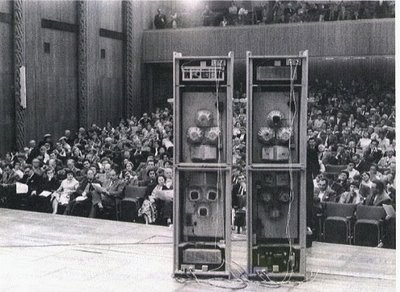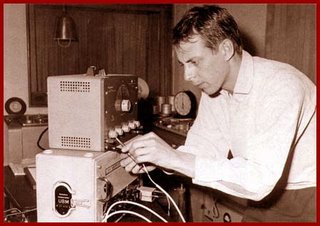
The computer, acknowledging the applause, returned for an encore
Karlheinz Stockhausen, Gesang der Jünglinge.
Clarence "Frogman" Henry, Ain't Got No Home.
Those who have read this blog for a while might remember that its original mandate was to cover all varieties of music from a given year, including "classical" (though that term scarcely applies to much of the compositions of the past half-century). Thus we've featured Prokofiev, John Cage and Richard Strauss in the past.
However, the classical wing of "Locust St" has been shuttered for some time now, so here's an attempt to revive it. Open the windows, pull the sheets off the furniture, beat out the dust.
"Gesang der Jünglinge," on first listen, seems so utterly removed from the popular forms of music produced in the same period that it sounds like an alien artifact, like a signal picked up by Sputnik. However, its influence on not only classical music but pop music was fairly colossal--variations on the electronic tones Stockhausen generated for this piece wound up in scores of science fiction films and TV shows in the '60s--the BBC's Doctor Who, in particular. And Stockhausen's influence on the Beatles, ranging from the use of tape spools in "Tomorrow Never Knows" to the creation of "Revolution No. 9", a composition almost directly mimicking "Gesang" and a later composition "Hymnen," is heavily documented. (And it was McCartney who loved Stockhausen first--Stockhausen was one of his choices of mourners for the cover of Sgt. Pepper.)
(A cruel joke to inflict on a bar you dislike--most bars have the White Album on their CD jukeboxes--just put in a dollar and select "Revolution No. 9" three times. The look on people's faces when, having gamely endured it once, the track starts again is priceless. Usually, bartenders kill the jukebox around this time.)
So, "Gesang der Jünglinge" (Song of the Youths):
Sometime in 1954, the German composer Karlheinz Stockhausen began writing a Catholic Mass for electronic sounds--he intended to debut the piece in the Cologne Cathedral, until the Church ruled against allowing loudspeakers to be placed there.
Stockhausen intended to fuse the human voice with computer-made sounds, something that had never been attempted on so broad a scale before. Working in West German Radio's Studio for Electronic Music, Stockhausen began by recording a 12-year old boy singing verses from an apocyrphal version of the Book of Daniel--the "song of the youths" the title refers to. These are the praises to God sung by the Hebrew youth hurled into the fiery furnace by King Nebuchadnezzar, and who emerged unscathed.
Some of the verses sung are:
Preiset den Herrn, aller Regen und Tau--
Preiset den Herrn, alle Winde.
Preiset den Herrn, Feuer und Sommersglut--
preiset den Herrn, Kalte und Starrer Winter.
(Praise to God, all rain and dew
Praise to God, all wind.
Praise to God, fire and summer's heat
Praise to God, cold and frigid winter)
Stockhausen manipulated the multiple recordings he made of the boy singing, using "Preiset den Herrn" as a sort of centerpiece, the reoccuring motif the piece is built around. Then, using a frequency generator, he created sine waves to match the vowel sounds from the boy's recording, and electronic white noise to match the consonant sounds.
And at last, Stockhausen mixed everything together--so that the shards of the boy's voice are made equivalent to the dabs of electronic squalls. While very much intended to be a devout work of praise to God, the result can seem quite horrifying and dehumanizing, the sound of the human being at prayer subsumed into a din of computer generated nightmares. But there are pieces of amazing beauty as well.
A caveat: listening to this compressed MP3 to get a sense of what Stockhausen did is like squinting at a low-bit-rate JPG file of a Van Gogh painting to see VG's brush strokes. For one thing, Stockhausen recorded the piece in five channels, and created an early version of "surround sound" to play it--five speakers placed around the performance space, so that noises would appear to be bouncing around, veering from behind you and reeling off the far distance.
It was premiered on May 30, 1956, in Cologne (photo shown above). Find on Stockhausen 3: Etude. Stockhausen is still composing today, his reputation tarred by some stupid remarks he made after the 9/11 attacks.
So enjoy. If you haven't hear "Gesang" before, you might hate it intensely, you might love it. Post your reactions if so inclined.

And then we have Clarence "Frogman" Henry. Consider it a rock & roll riposte to Karlheinz--Henry says he can sing like a girl (allegedly an imitation of Shirley Goodman), and sing like a frog, all without the aid of any electronic manipulation. And so he does.
Clarence Henry was born in Algiers, Louisiana, in 1937, and played with the Bobby Mitchell band in New Orleans. Paul Gayten, one of the great New Orleans arrangers and composers, discovered Henry and convinced him to go solo, co-writing "Ain't Got No Home" with him. Mr. Henry's home was damaged during Hurricane Katrina, but thankfully he came out all right.
"Ain't Got No Home" was released in October 1956 as Argo 5259. Find here.
Apropros of nothing dept.: For some reason, I've become the number one source, according to Google Images, of a photograph of the writer Mary McCarthy (it's not even on the site--I linked to it in one of the "drinks" posts). That's fine, but what bewilders me is that I now get about three dozen or more people a day hitting this site in search of the picture. Who knew there was such a demand for Mary McCarthy photos? I mean, it's a nice picture--she's very pretty--but, still, it's all a bit odd.
No comments:
Post a Comment